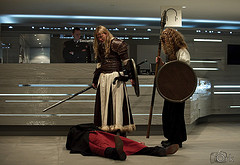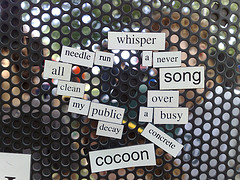 After an interesting conversation with @harryharrold and @MrRickWaghorn yesterday, I’ve been mulling a few thoughts on emergent stories and how the social side of the web could make it possible to curate and (to some extent) formalise them.
After an interesting conversation with @harryharrold and @MrRickWaghorn yesterday, I’ve been mulling a few thoughts on emergent stories and how the social side of the web could make it possible to curate and (to some extent) formalise them.
As @harryharrold pointed out, one of the big problems LARP events haven’t solved yet is how to deal with emergent stories after the fact. Unless you’re physically present at an event it’s next-to-impossible to get a coherent narrative of what actually happened, particularly if it’s a big fest event.
In my experience narratives split into two general categories after LARP events – the big picture and the little details. For some players/characters and events, the big picture is what’s important; they have enough of an impact on the overarching plot plot and the overarching plot is reachable enough for them to be satisfied with a global grand plot update.
But for most events and most players, what’s important and relevant is the nitty-gritty of their immediate social circle. Who said and did what to whom; the “little” stories of betrayal and intrigue and death and love. And that’s incredibly hard to track.
A big part of what we do at Zombie is making sure that individual players get their stories straight before they forget anything. We have “debrief” sessions so that both the refs and the players can get a handle on the emergent stories that have happened on each run, and we do our best to encourage storytelling online after the game. But that only works because every run is self-contained; with a larger plot edifice and continuing characters such a simple system is simply impossible.
But LARP isn’t the only area to have this problem. Festivals, conferences and conventions do too; in fact any large event where multiple trajectories are possible and no individual experience is large enough to express the story of what happened.
Here’s an idea I was contemplating pitching for Greenbelt this year or next. Hand out 10 relatively smart phones to 10 people, picked as a good spread of the demographics at the event. Kit them out with Twitter feeds if they don’t already have them, photoblogging, moblogging and microblogging kit, basic video, audio and still image hardware, and make it as easy as possible for them to upload anything and everything, wherever they are. Track everything they do, geotagged and timestamped, and from that collate and curate a livecast of the event.
I’d love to see if it’s possible to combine @harryharrold’s ideas on curating LARP stories and map them onto other events too. Emergent stories are popping up all over the place and the social web is making it possible to collaborate and build interactive, explorable maps of events that previously have had linear narratives. The stable social experience is exploding and we all want to choose our own adventure. Perhaps we can apply this to more than just LARP.
